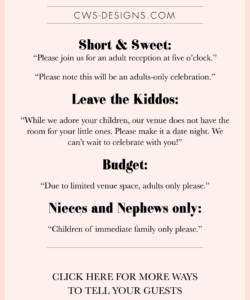Wedding invitations are a special way to invite your loved ones to celebrate your big day. They often require careful wording and significant details, especially when it comes to indicating whether guests can bring a plus one. Deciding how to word your invitation can be tricky, especially if you’re unsure about the appropriate etiquette or want to avoid any misunderstandings. This guide will delve into the nuances of “plus one” wording on wedding invitations, providing you with tips and examples to help you craft the perfect invitations.
Before you begin drafting the invitation wording, it’s crucial to establish the guest list and budget. Once you know the number of guests you can accommodate, you can start considering whether or not to include a “plus one” option. It’s generally considered polite to offer a plus one to guests who are married or in a long-term relationship, but it’s ultimately up to you and your partner to decide what works best for your wedding.
Once you’ve made a decision, it’s time to choose the wording for your invitation. Here are some tips to keep in mind:
Navigating the Nuances of Plus One Wording
When wording your invitations, there are several factors to consider. You’ll need to decide whether to include a “plus one” option for all guests or only for certain individuals. If you choose to extend a plus one to all guests, you can use general wording like “and guest” or “and a companion.” However, if you want to limit the plus one option to specific guests, you’ll need to be more specific in your wording.
For example, you could write “and guest” next to the names of guests who are married or in a long-term relationship. Alternatively, you could write “and a companion” next to the names of guests who you know are single or who may not have a significant other.
Another important consideration is whether or not to include the guest’s name on the invitation. If you choose to include the guest’s name, make sure to use their first name only or their first and last initial. You should also avoid using the term “significant other” or “date,” as these terms can be considered offensive to some guests.
Finally, it’s important to be consistent with your wording throughout the invitation. If you include a plus one option for some guests, be sure to include it for all guests. You should also use the same wording for all guests, regardless of their relationship status.
Examples of Plus One Wording
Here are some examples of “plus one” wording that you can use on your wedding invitations:
- Mr. and Mrs. John Smith and guest
- Mr. and Mrs. John Smith and a companion
- Mr. and Mrs. John Smith (plus one)
- John Smith and a guest
- John Smith and a companion
- John Smith (plus one)
- John Smith and Jane Doe
- John Smith and J. Doe
The Importance of Clear Communication
The wording on your wedding invitations should be clear and easy to understand. Your guests should be able to tell at a glance whether or not they are invited to bring a plus one. If you are unsure about the wording, it’s always a good idea to ask a friend or family member to proofread your invitations before you send them out.
By carefully considering the wording of your wedding invitations, you can ensure that your guests are clear about whether or not they are invited to bring a plus one. This will help to avoid any misunderstandings or hurt feelings, and it will ensure that everyone has a wonderful time at your wedding.


